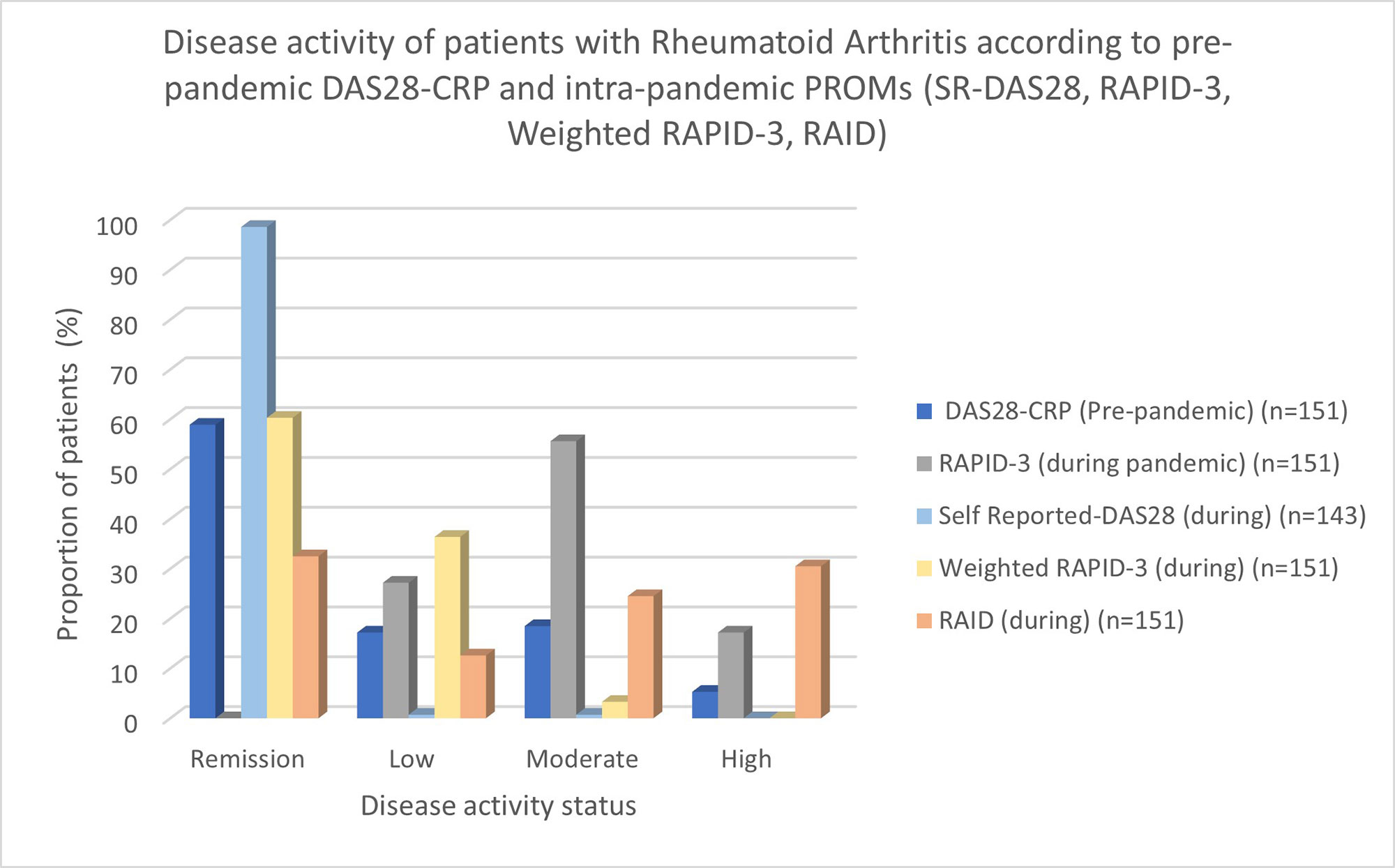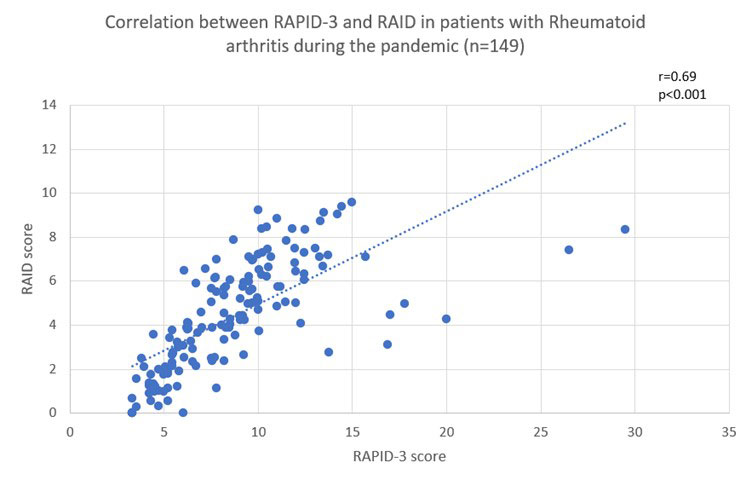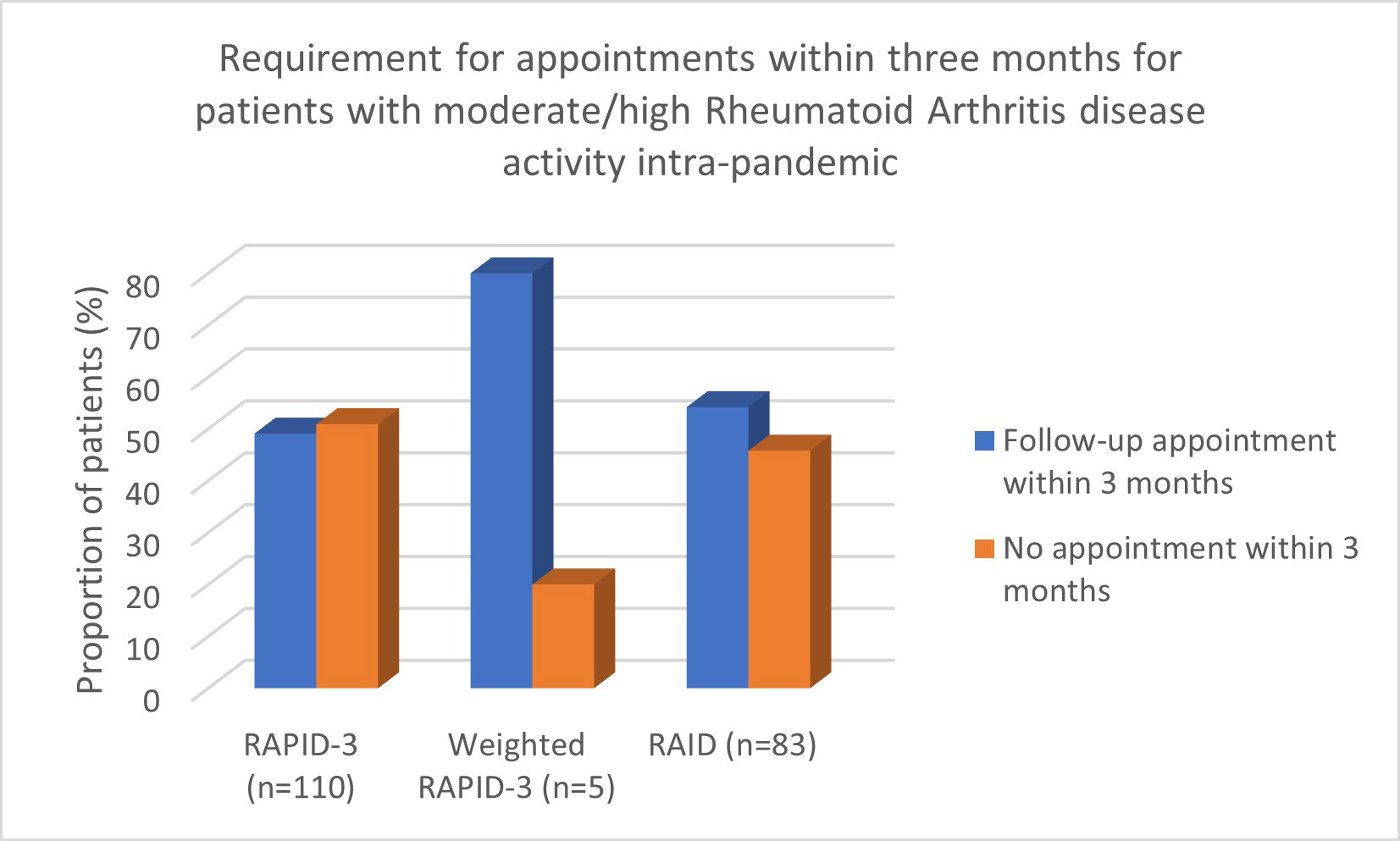Session Information
Session Type: Poster Session C
Session Time: 1:00PM-3:00PM
Background/Purpose: During the COVID-19 pandemic, asynchronous consultations were introduced due to the significant backlog of patients with Rheumatoid arthritis awaiting clinical review. PROMs including Self-Reported Disease Activity Score-28 (SR-DAS28), Rheumatoid Arthritis Impact of Disease (RAID), Routine Assessment of Patient Index Data 3 (RAPID-3) and weighted RAPID-3 (RAPID-3 score divided by three) were assessed and compared with pre-pandemic clinician-assessed DAS28-CRP for the same patients. Furthermore, we evaluated whether moderate/high disease activity resulted in an appointment within three months, a measure of poor outcome.
Methods: We analysed the data pre-pandemic, from 01/01/2019-31/12/2020, and during pandemic from 01/11/2020-31/12/2021. During the pandemic, pre-clinic electronic surveys used for remote consultations were sent to patients. The data was passed into a secure database for calculation of PROMs. Statistical analysis comparing PROMs was performed using Pearson correlation coefficient.
Results: Out of 151 patients with RA, 72% reported moderate/high disease activity according to RAPID-3, whereas no patient was in remission (Figure 1). Notably, 16 out of 28 patients who were previously in remission according to pre-pandemic DAS28-CRP had moderate disease activity intra-pandemic. However, weighted RAPID-3 characterised 96.7% of patients as being in remission or having low disease activity (Figure 1). Disease activity according to RAID was more evenly distributed; 55% of the cohort exhibited moderate/high disease activity (Figure 1).
We showed a significant correlation between RAPID-3/weighted RAPID-3 and RAID (r=0.69, p< 0.001) (Figure 2); especially when RAPID-3 ≤15 (and weighted RAPID-3 ≤5) (r=0.84, p< 0.001). Self-Reported DAS28 did not correlate strongly with either RAID (r=0.22, p=0.0079) or RAPID-3 (r=0.21, p=0.013).
54% of patients with moderate/high disease activity according to RAID (n=83) and 49% according to RAPID-3 (n=110) required review within three months (Figure 3). Four out of five patients with moderate/high weighted RAPID-3 scores required a follow-up within three months (Figure 3).
Conclusion: RAID and RAPID-3 correlate particularly strongly at low disease activity. SR-DAS28 is not effective in indicating RA disease activity. RAPID-3 and weighted RAPID-3 skewed the cohort towards high disease activity and remission respectively. Conversely, RAID provides a more even distribution of patients across different disease activity statuses. Moderate to high weighted RAPID-3 scores were the best predictors for poor outcome (appointment within three months).
To cite this abstract in AMA style:
Mirza M, Song K, Ashraf M, Soni A, Jackman J, Luqmani R. Comparing Data on Rheumatoid Arthritis (RA) Disease Status Using Patient Reported Outcome Measures (PROMS) RAID/RAPID-3/Self-Reported DAS28 in Remote Electronic Monitoring During the COVID-19 Pandemic with Face-To-Face Clinical Evaluation (DAS28-CRP) Performed Pre-Pandemic [abstract]. Arthritis Rheumatol. 2022; 74 (suppl 9). https://acrabstracts.org/abstract/comparing-data-on-rheumatoid-arthritis-ra-disease-status-using-patient-reported-outcome-measures-proms-raid-rapid-3-self-reported-das28-in-remote-electronic-monitoring-during-the-covid-19-pandemic/. Accessed .« Back to ACR Convergence 2022
ACR Meeting Abstracts - https://acrabstracts.org/abstract/comparing-data-on-rheumatoid-arthritis-ra-disease-status-using-patient-reported-outcome-measures-proms-raid-rapid-3-self-reported-das28-in-remote-electronic-monitoring-during-the-covid-19-pandemic/



